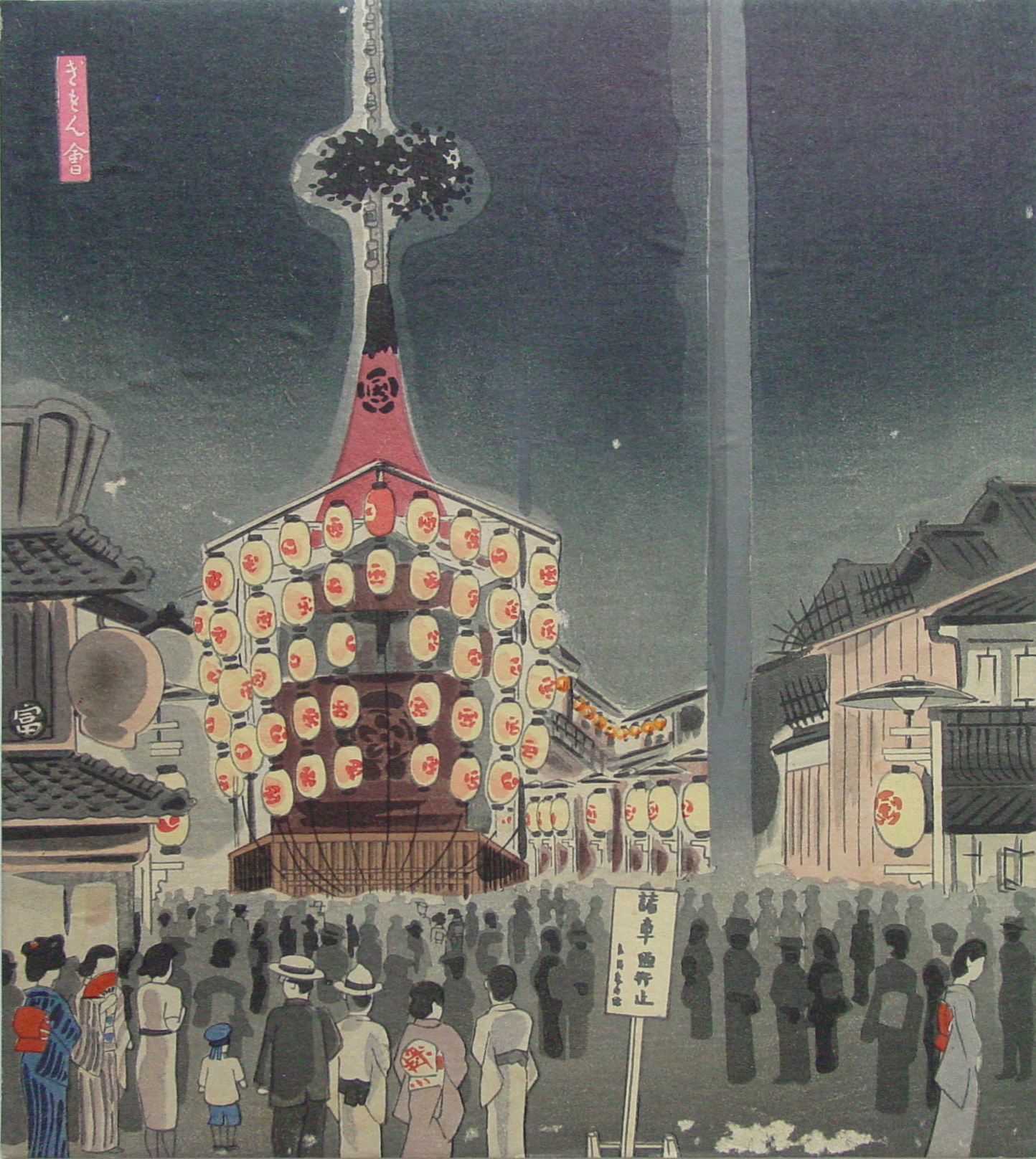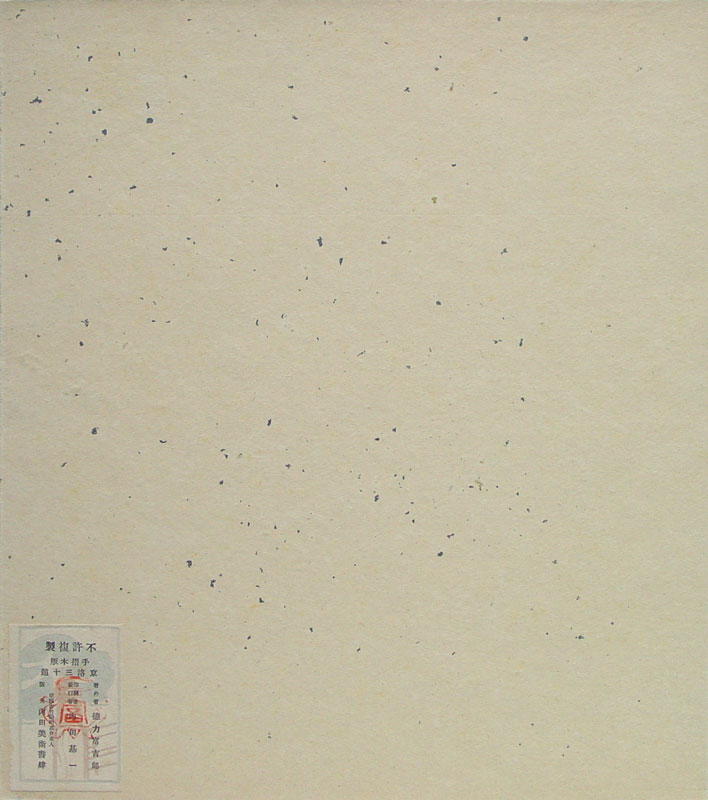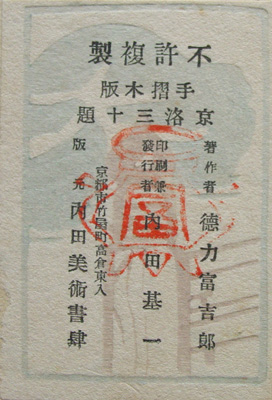About This Print
This print, picturing the festivities on the night before the Gion Festival in Kyoto, is the original issue (first edition) published by Uchida Art Store (Uchida Woodblock Printing Company) in 1936 as part of the series Thirty Subjects [Views] of Kyoto. Uchida mounted these prints on a display board with Tokuriki’s authentication seal on the reverse (see detail of board verso and label below.) These square format prints on board were part of a premium set of designs originally sold in a handmade box. For an image of the box, please see Index for the series Thirty Subjects [Views] of Kyoto.This same print, with modifications to the title and the addition of the artist's name 富吉郎 in the upper left of the print, the removal of the artist's seal in the lower left-hand corner and not mounted on board, was later released as part of the series Twelve Months of Kyoto (Kyō-meisho junikagetsu), as shown below.
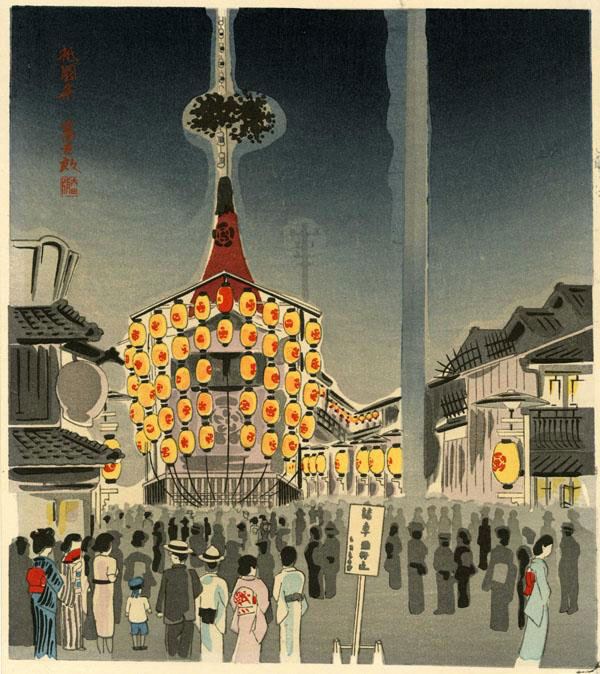
Gion Matsuri is an annual festival of the Yasaka Shrine which begins July 1 and continues through July 31. During this period, a series of Shinto rituals and events take place at Yasaka Shrine and others locations in Kyoto. Yasaka Shrine was originally named Gion-sha and is the head shrine of the thousands of Gion-sha shrines in Japan.
The Gion Matsuri was started in 869 A.D when a bad plague spread in Kyoto. In the first festival, young men carried numbers of wooden floats as a divine intervention to stop the plague. The plague soon ended, and this event became a popular festival. The current form of the decorated floats appeared in the festival during the Edo period.
Yamahoko-junko is the procession of colorful floats through downtown Kyoto. The floats are pulled through the streets by teams of men dressed in traditional costumes.
There are two kinds of floats: yama and hoko. Yama are smaller floats (weight: 1.2 ton - 1.6 ton, height: about 6m) and carried by people on their shoulders. Hoko are giant floats (weight: 4.8 ton - 12 ton, height: about 25m) on large wooden wheels and pulled by people. There are 32 floats in the procession: 25 yama floats and 7 hoko floats.
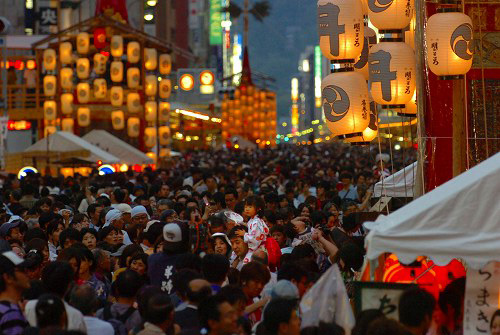
1 The publication date for this series has variously been given as 1933-34, 1936, 1937, 1938 and 1939.
2 The Carnegie Museum of Art notes that their collection's print is "from the series Views of New Kyoto (Shin Kyoto Jukei)" (as opposed to other sources that state the series was Thirty Views of Kyoto) and dates the print from 1933-34.
last revision:

Re-issued print, 1945
Procession of Yama-Hoko or Floats at Gion Festival - July
from the series Twelve Months of Kyoto
Procession of Yama-Hoko or Floats at Gion Festival - July
from the series Twelve Months of Kyoto
Size: 10 1/4 x 11 1/2 in.
Gion Festival
Source: About.com website http://gojapan.about.com/cs/japanesefestivals/a/kyotogionfes.htmGion Matsuri is an annual festival of the Yasaka Shrine which begins July 1 and continues through July 31. During this period, a series of Shinto rituals and events take place at Yasaka Shrine and others locations in Kyoto. Yasaka Shrine was originally named Gion-sha and is the head shrine of the thousands of Gion-sha shrines in Japan.
The Gion Matsuri was started in 869 A.D when a bad plague spread in Kyoto. In the first festival, young men carried numbers of wooden floats as a divine intervention to stop the plague. The plague soon ended, and this event became a popular festival. The current form of the decorated floats appeared in the festival during the Edo period.
Yamahoko-junko is the procession of colorful floats through downtown Kyoto. The floats are pulled through the streets by teams of men dressed in traditional costumes.
There are two kinds of floats: yama and hoko. Yama are smaller floats (weight: 1.2 ton - 1.6 ton, height: about 6m) and carried by people on their shoulders. Hoko are giant floats (weight: 4.8 ton - 12 ton, height: about 25m) on large wooden wheels and pulled by people. There are 32 floats in the procession: 25 yama floats and 7 hoko floats.

1 The publication date for this series has variously been given as 1933-34, 1936, 1937, 1938 and 1939.
2 The Carnegie Museum of Art notes that their collection's print is "from the series Views of New Kyoto (Shin Kyoto Jukei)" (as opposed to other sources that state the series was Thirty Views of Kyoto) and dates the print from 1933-34.
Print Details
| IHL Catalog | #250 |
| Title | きをん會 Gionkai (Gion Festival) - title given on the print 祇園祭宵山 Gion yoiyama (the festivities the evening prior to the Gion Festival) - title given in the table of contents note: also seen translated as Thirty Aspects of Kyoto |
| Series | 京洛三十題 (Kyōraku sanjū dai) Thirty Views of Kyoto |
| Artist | Tokuriki Tomikichirō (1902-2000) |
| Signature | unsigned |
| Seal | tomi (center left corner of image)  |
| Date | 1936 |
| Edition | original (first) edition |
| Publisher | Uchida bijutsu shoshi 内田美術書肆 |
| Impression | excellent |
| Colors | excellent |
| Condition | good - light curling of backing board; losses at bottom right corner and several small spots across center; minor bubbling caused by separation of print from backing |
| Genre | shin hanga (new print) |
| Miscellaneous | |
| Format | shikishiban |
| H x W Paper | 10 5/8 x 9 1/2 in. (27 x 24.1 cm) |
| Collections This Print | Carnegie Museum of Art 89.28.1359; Museum of Fine Arts, Boston 52.514 (later printing) |
| Reference Literature | Modern Japanese Prints: The Twentieth Century, Amanda T. Zehnder, Carnegie Museum of Art, 2009, p. 175. |
10/25/2018


